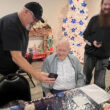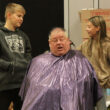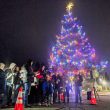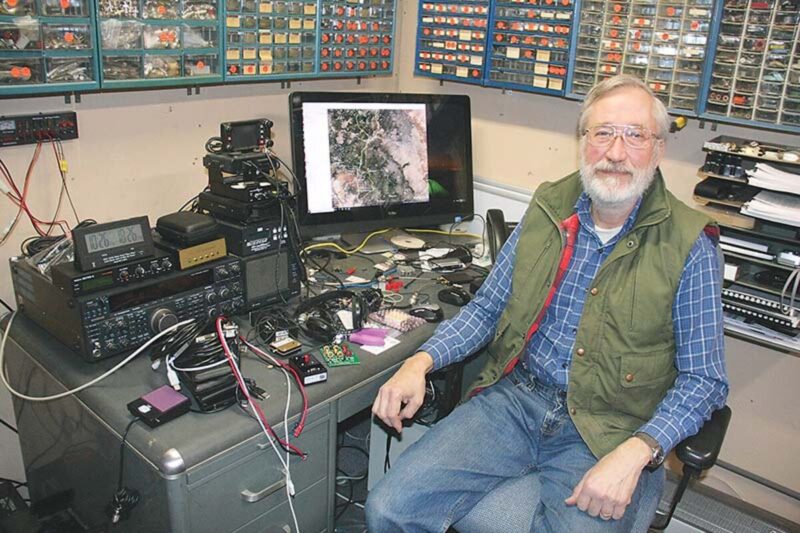Sean C. Morgan
At his home on Marks Ridge, August Johnson, 61, can often be found in a small shop filled with radios and electronics along with the tools and parts he uses to tinker and repair radios and other electronics.
He may be listening in on a transmission from someone a world away or talking to another ham radio operator across the county. Outside the shop is a radio tower mounted with a repeater to help improve communications in the Sweet Home area, in which line-of-sight communications out of the area is difficult because of hills surrounding the town.
Sheriff Bruce Riley presented Johnson with the Amateur Radio Emergency Service Volunteer of the Year Award during the Linn County Sheriff’s Office’s annual awards ceremony on Feb. 7.
Johnson trains those interested in ham radio and aids in testing those ready to apply for a federal license to operate amateur radio.
With poor line-of-sight, when a catastrophe happens, cell phones and Internet may be useless. To help maintain communications during an emergency, Johnson installed the repeater station on his Marks Ridge property.
He also has helped install ham radio in the Sweet Home Fire and Ambulance District’s Fire Hall and is in the process of installing one in the Sweet Home Police Department. The work will provide radio access among Sweet Home, Lebanon, Albany and the rest of the world in the event of a disaster.
Johnson also has provided equipment and many hours of training to the Samaritan Lebanon Community Hospital ARES group.
Johnson has been tinkering all his life, and ham radio is a natural extension of that.
“Ham radio is a really interesting thing – and it’s useful,” Johnson said. As part of the Linn County ARES group, he supports the Sheriff’s Office and other emergency responders with communication when cell phones won’t work.
In a widespread emergency, cell phones won’t work, he said. “They get overloaded, and nothing works.”
He noted that cell service in Sweet Home already runs into trouble during the Oregon Jamboree when the community has thousands of visitors.
Back in 2002 or 2003, Johnson was working for a power utility in the Lakeside, Ariz., area during a 500,000-acre fire. Nothing had damaged the cell phone system, but the fire service had turned off cell service in the area.
Ham radio worked.
Ham radio was key in the recent rescue efforts in Puerto Rico following Hurricane Maria last year, Johnson said. In addition to the ham operators already in the country, the Red Cross requested 50 ham operators to respond.
“For decades, ham radio’s purpose has been emergency communications when everything fails,” Johnson said. “Initial communications in all these places is always ham radio.”
Cell phone users are relying on billions of dollars of other people’s infrastructure to talk, Johnson said. Ham radio simply requires each end of a conversation to have a radio; and right now, he can talk to people all over the country.
As a hobby, a ham operator may climb a mountain, throw a wire over a tree and talk to people across the United States, Johnson said. Some participants just like to build radios. Others like to travel “to see just how many people they can talk to in the world.”
Some enjoy sending up a balloon with a transmitter and tracking where it goes, he said. As a hobby, it’s got a wide variety of opportunity for fun.
“Ham radio is the original social media,” Johnson said. The International Space Station is a ham station, and astronauts occasionally speak directly to classrooms from the station.
But the very first reason for ham radio is emergency communications, Johnson said.
“The hobby part helps you be prepared,” Johnson said. “You’re preparing yourself for other things.”
He has been interested in electronics all his life, he said, and he received his ham license in 1986 after a high school friend prodded him into it. Since then he has built and operated his own radios.
While commercial radios are available, many today continue to build their own radios from scratch, Johnson said. A radio can be built from almost any electronics “you can scrounge.” Putting them together helps ham radio operators learn develop a variety of skills and “how to make do with less.”
“Sweet Home, if something does happen, will be isolated,” Johnson said. When he and his wife moved to Sweet Home 4½ years ago, he thought his 1½ acre piece of Marks Ridge would be the perfect place for a repeater to prevent the isolation.
The repeater can help ham radio operators reach Lebanon, Albany or even Salem, he said. It can run for a week on battery power, and it can be recharged using a generator for longer-term emergencies.
“We use it all the time,” Johnson said. “On Monday nights, we have what we call a net,” when members of ARES formally check in to ensure their equipment is working.
Johnson moved to Sweet Home after leaving Arizona and a 1½ year stop in northern California. His wife, Debra, was born in Salem. They had a friend in the area. They asked what it was like, visited and then moved to Sweet Home.
In Arizona, Johnson worked as a technical engineer in physics, astronomy and other departments at the University of Arizona for 19 years. He moved to a cooler area of the state and worked for the power company until retiring and leaving the state.
Working with Edie Wilcox, Johnson teaches a ham radio class to prepare people to take the test for a license. The current class will end in mid-March, and he will offer another afterward.
“We need more people interested in ham radio to communicate in emergencies,” Johnson said, adding that he would love to have a network of 50 to 100 operators throughout the Sweet Home area.
For more information about ham radio, visit the National Association for Amateur Radio at arrl.org.
For more information about classes, contact Wilcox at (541) 401-0188.





